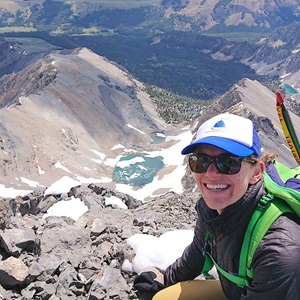Jessica Stanley
Jessica Stanley
Assistant Professor
McClure 303B
208-885-4704
Department of Earth and Spatial Sciences
University of Idaho
875 Perimeter Drive MS 3025
Moscow, Idaho 83844-3025
- PhD in Geological Sciences, University of Colorado at Boulder, 2015
- M.S. in Earth and Planetary Sciences, Massachusetts Institute of Technology, 2009
- B.S. in Earth, Atmospheric, and Planetary Sciences, Massachusetts Institute of Technology, 2008
Research/Focus Areas
- Continental tectonics
- Thermochronology
- Links between mantle dynamics and surface processes
- Landscape evolution modelling
- Surface history of cratons and continental interiors
Uplift and unroofing history of the southern African Plateau.
The southern African Plateau is a first order topographic feature of the African continent with an average surface elevation of ~1000m. Elevation gain in southern Africa occurred while distal from convergent plate boundaries leading many researchers to suggests mantle-related mechanisms for uplift, but there is great disagreement about the timing and causes of surface uplift. This project focuses on using (U-Th)/He thermochronometry, particularly on kimberlites, to understand regional erosion patterns in southern Africa. Combining these erosion constraints with information on the evolution of the lithospheric mantle from kimberlite-borne xenoliths we can examine the potential geodynamic mechanisms for surface change in southern Africa.
Constraining continental plateau uplift with landscape evolution model inversion and erosion history data.
Continental plateaus are complex manifestations of the interaction of tectonic, deep earth, and surface processes. Their formation mechanisms are not fully understood, in part because the timing and pattern of plateau uplift of is often not well known. Surface uplift is difficult to detect directly in the geologic record, but topographic uplift generally triggers an erosional response. This project takes advantage of this relationship to constrain plateau uplift by integrating an efficient landscape evolution model (FastScape) with low temperature thermochronology, topography, and sedimentary flux data which constrain the erosion history over a variety of spatial and temporal scales. An inversion scheme is used to explore which uplift histories can reproduce the observed data.
Dating kimberlite eruption with mid-T (U-Th)/He thermochronometers and development of the perovskite (U-Th)/He thermochronometer.
Accurate dating of kimberlite eruption is important for constraining the spatiotemporal trends of modification of the cratonic lithosphere and also the timing of phases of cratonic erosion. However, kimberlites are often difficult to date by conventional isotopic methods. This project looks at the utility of the middle temperature thermochonometers of zircon and perovskite (U-Th)/He (ZHe and PHe) dating for dating eruption of kimberlites. It also explores the temperature sensitivity of the perovskite (U-Th)/He system, which has not previously been studied extensively.
The southern African Plateau is a first order topographic feature of the African continent with an average surface elevation of ~1000m. Elevation gain in southern Africa occurred while distal from convergent plate boundaries leading many researchers to suggests mantle-related mechanisms for uplift, but there is great disagreement about the timing and causes of surface uplift. This project focuses on using (U-Th)/He thermochronometry, particularly on kimberlites, to understand regional erosion patterns in southern Africa. Combining these erosion constraints with information on the evolution of the lithospheric mantle from kimberlite-borne xenoliths we can examine the potential geodynamic mechanisms for surface change in southern Africa.







